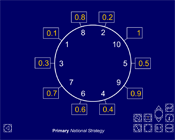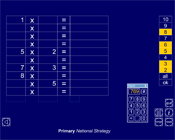Consolidation and practice
These resources are to support children in guided or independent work. Roll over the highlighted resources for a description.
Number dials

This interactive teaching program (ITP) is an ICT-based tool to support the exploration and recall of multiplication and division facts. Number dials ITP allows the child or teacher to generate sets of products of a central number and numbers from 1 to 10. The ITP can be used to practise multiplying and dividing by one- and two-digit whole numbers and decimals.
Multiplication tables

This interactive teaching program (ITP) is an ICT-based tool to support the exploration of multiplication facts. Multiplication tables ITP allows the child or teacher to set up one or more multiplication tables, hiding or revealing either of the factors or the product. Decimal numbers can be explored using the keypad.
Opportunities to use and apply
Possible contexts include:
- written calculations, e.g. Solving 4.8 × 3 by calculating
4 × 3 and then 0.8 × 3. Extend this to decimals with up to two decimal places, for example, 4.82 × 3.
- word problems, e.g.
- My pencil is 9.2 cm long. My desk is 6 pencil-lengths wide. How wide is the desk, in centimetres?
- Six packets of crisps cost £1.20. How much does each packet cost in £s?
- solving number puzzles, e.g. Find a number of which the double lies between 1.3 and 1.4. Can you find more than one?
Confirming learning
Ask probing questions such as:
- Explain how you would find half of 18.36.
- How many different multiplication and division facts can you find, using what you know about 72? What if you started with 7.2? 0.72?
- The answer to a multiplication or division calculation is 0.56. What could the calculation be? How many possibilities can you find?
- Are any of the following incorrect?
0.7 × 0.8 = 5.6
8 × 0.8 = 6.4
56 ÷ 0.7 = 8
Explain why and how you know, using words or diagrams.
 ×
×  = 3.2
= 3.2  = 0.4.
= 0.4. Knowing and using number facts
Knowing and using number facts

